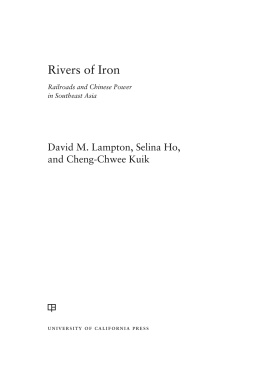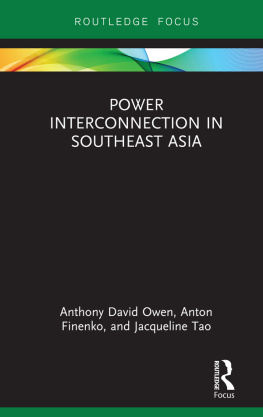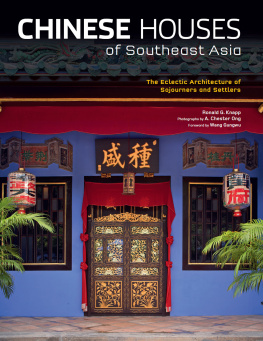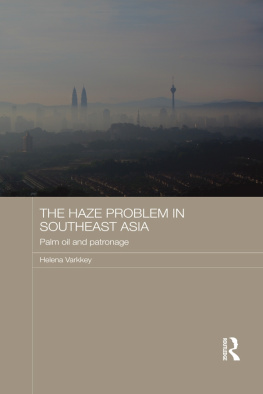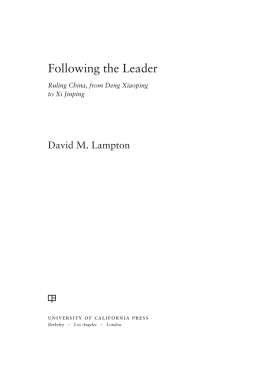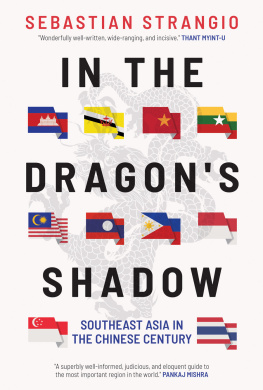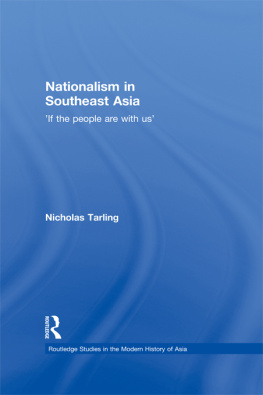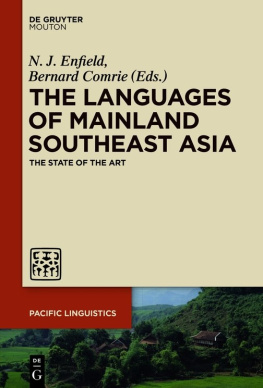The publisher and the University of California Press Foundation gratefully acknowledge the generous support of the Philip E. Lilienthal Imprint in Asian Studies, established by a major gift from Sally Lilienthal.
University of California Press
Oakland, California
2020 by David M. Lampton, Selina Ho, and Cheng-Chwee Kuik
Library of Congress Cataloging-in-Publication Data
Names: Lampton, David M., author. | Ho, Selina, author. | Kuik, Cheng-Chwee, author.
Title: Rivers of iron : railroads and Chinese power in Southeast Asia / David M. Lampton, Selina Ho, Cheng-Chwee Kuik.
Description: Oakland, California : University of California Press, [2020] | Includes bibliographical references and index.
Identifiers: LCCN 2019057897 (print) | LCCN 2019057898 (ebook) | ISBN 9780520372993 (cloth) | ISBN 9780520976160 (ebook)
Subjects: LCSH : RailroadsPolitical aspectsChina21st century. | Southeast AsiaForeign relationsChina21st century. | ChinaForeign relationsSoutheast Asia21st century.
Classification: LCC HE 3288 . L 35 2020 (print) | LCC HE 3288 (ebook) | DDC 385.0959dc23
LC record available at https://lccn.loc.gov/2019057897
LC ebook record available at https://lccn.loc.gov/2019057898
Manufactured in the United States of America
29 28 27 26 25 24 23 22 21 20
10 9 8 7 6 5 4 3 2 1
Preface
Setting the Stage
This volume explores Chinas current effort to join with its continental Southeast Asian neighbors and Singapore to realize a broadly shared vision of connecting the Peoples Republic of China (PRC) to its southern neighbors by a high- and conventional-speed rail network. This effort needs to be understood from many perspectives, one of which is the context of the last four decades accumulated economic, political, and policy developments in China that have made this effort possible and driven it forward. This undertaking in Southeast Asia also needs to be viewed in the context of Beijings broader national purposes, namely to sustain growth at home and change the political and economic geography of the PRCs entire periphery in a direction favorable to Chinas economic and strategic interests. These past developments and current purposes and interests predictably create reactions among other states in the region and beyond that are important considerations throughout this book.
Looking back to the time of Chairman Mao Zedongs 1976 death, the PRC was economically impoverished and unable to effectively project economic, military, or intellectual power much beyond its own borders. To address the gigantic challenges facing the nation that Mao had bequeathed to his successors, beginning from the late 1970s Deng Xiaoping focused on domestic economic development energized by market incentives, human and institutional capacity building, and reassurances to the world that China would be benign as its power grew. By pairing gains in modernization with foreign policy reassurances, Deng fostered a pacific external environment that provided a strategic window of opportunity for China to grow unmolested. Much like George Washington, Deng wanted to free his country of premature and costly entanglements that might detract from the task at handmodernization.
To this end, Deng was more than willing to have his country temporarily play the part of student to more modern countries, notably the United States. He even instructed his officials to learn from Singapore, a small city-state. and after a costly 1979 border war with Vietnam the PRC waged no other large-scale bloodlettings, though there were a few territorial skirmishes along the way, including South China Sea encounters with Vietnam. All in all, Dengs two immediate successors carried on the broad modernization strategy of reform and opening ( gaige kaifang ) in ways largely compatible with Dengs vision. Indeed, Deng had chosen both Jiang Zemin and Hu Jintao as his sequential successors in order to enhance the prospects of policy continuity, something entirely absent from the tumultuous Mao era.
By 2010, however, in the last one-fifth of Hu Jintaos period in office, the PRCs comprehensive national power had multiplied and Washington had become distracted, if not hobbled, by prolonged post-9/11 conflicts (Afghanistan, Iraq, and smaller-scale operations in Africa, Central Asia, and the Middle East), the global financial crisis of 20089, and political gridlock in Washington born of domestic economic inequality and political polarization. In Beijing, Hu Jintaos successor, Xi Jinping, came to power in 201213 and concluded that the combination of Chinas enormous growth and Americas unexpected faltering had combined to create an opportunity for China to step out of the international shadows and resume a great power role after more than 150 years. For their part, the Chinese people are proud of their accomplishments and anxious to play a greater and more respected role in the world. Chinas military wants to be a key instrument of the nations further renewal, to more assertively defend sovereignty claims, and to protect the PRCs expanding equities in its region and globally.
The birth of the Belt and Road Initiative and reactions to it. A signal event heralding in this new era was Xi Jinpings announcement in late 2013 of the One Belt, One Road ( yidai yilu ) initiative (later rebranded as BRI, or the Belt and Road Initiative), an effort to construct infrastructure linking the PRC to its land and sea periphery at all compass points. In two speeches in 2013, one in Kazakhstan in September and the other in Indonesia in October, President Xi proposed creating a Silk Road Economic Belt and a Maritime Silk Road Initiative. The grand vision was to create both land and sea connectivity by constructing a web of infrastructure (roads, ports, pipelines, air, rail, cyber, power grids, etc.) as well as people-to-people and other connectivity. Despite the linguistic confusion of land belts and watery roads, this broad policy umbrella has subsequently provided a hook upon which a very dynamic Chinese system can hang an endless number of infrastructure-building and connectivity projects, provide considerable financing to kick-start them, and promote the export of materials and human resources that China has in abundance. This effort also holds out the prospect of constructing an economic and strategic system with China as its hub. Its essence is the creation of economic and other power projection platforms at 360 degrees from China itself.
In May 2014, in remarks that have not been authoritatively repeated since, Xi signaled the underlying impulse of this overall effort, calling for letting the people of Asia run the affairs of Asia, solve the problems of Asia and uphold the security of Asia. Thereafter, at October 2017s Nineteenth Party Congress, Xi had pursuit of the BRI written into the Party Constitution and at the subsequent National Peoples Congress held the following spring, Xi engineered the elimination of term limits that applied to him as Chinas head of state. By early 2018, therefore, one could clearly see that China had entered the post-Deng era both domestically and in terms of its foreign policy. China was no longer hiding the bright light of its national ambitions under a bushel ( tao guang yang hui ), it now had a leader who had the will, constitutional sanction, and potential longevity to pursue a massive international infrastructure-building effort, and the PRC now had much greater resources and advanced technologies with which to pursue those ambitions.



